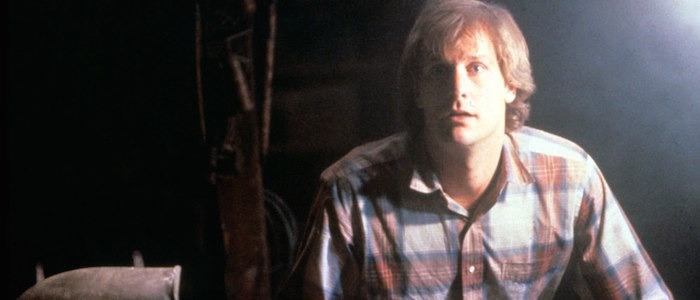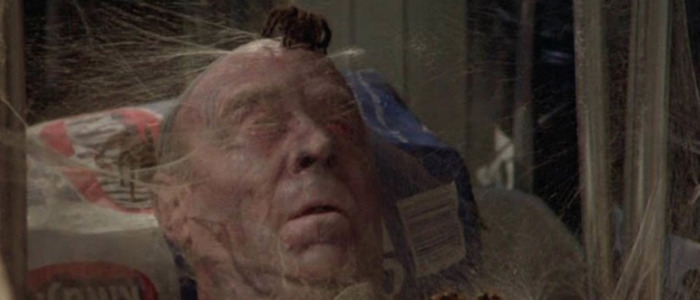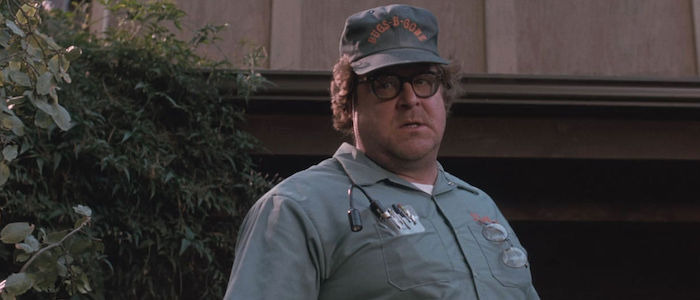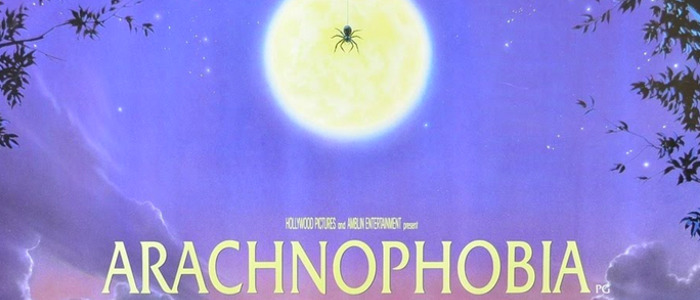Eight-Legged Freaks: Revisiting The Creepy And Crawly 'Arachnophobia'
We may receive a commission on purchases made from links.
In the annals of genre cinema, Arachnophobia is a slightly strange case. The feature directorial debut of Frank Marshall – co-founder of Amblin Entertainment with Steven Spielberg and Kathleen Kennedy – it arrived in theaters on July 18th, 1990, as the first title released beneath Disney's Hollywood Pictures banner, which was founded so the studio could unveil more adult-oriented fare. Arachnophobia received solid reviews, was a modest box office hit – placing #3 behind Ghost and Die Harder before raking in $55 million total on a budget of $22 mil – and became a VHS staple for an entire generation of '90s kids. Ask most folks in their mid-30s these days, and they can cite whole scenes involving the picture's practically rendered poisonous arachnids that scared the bejeezus out of them, doing for popcorn bowls what Psycho did for showers.
Still – thanks to format changeovers and market demand – Arachnophobia has also become something of home video relic. There's an OOP bargain bin Blu-ray you can snag for a few bucks on Amazon, and a decent HD stream available at the same mega retailer. Nevertheless, its omnipresence somehow seemed to skip a generation, remaining in those Gen Xers' nightmares, while the other scary classics Marshall produced with Spielberg (namely: Poltergeist and Gremlins) endured and solidified themselves in the Millennial pop culture vernacular. Perhaps it was simply due to iconography, as ghostly girls and green demons were burned into memory much easier than simple spiders. Or maybe the title of the film itself became an odd bit of self-fulfilling prophecy, as legions of potential movie-watchers steered clear since spiders creep people out on the regular during their everyday existences.
This could all change in 2019, as James Wan just announced that he will be producing a remake of Arachnophobia for this new generation of fright fans, continuing his rather lucrative role as a torch-bearer for audience members who weren't quite raised on blood-splattered magnetic tape. Just as Poltergeist has been redone (and Gremlins has been threatened to be made over), the revived creative interest in the title will certainly cause the curious to drop some quick cash on a disc or (more likely) a stream into their living rooms, where those little brown beasties can wreak havoc on a whole new set of psyches. For this writer, revisiting the movie thanks to the news of Wan's redux was a peculiar trip down memory lane, complete with the pleasant revelation that Marshall's original holds up even better than expected.
Amblin’s Greatest Hits
There's a joyous aura that radiates off the best Amblin productions that Arachnophobia captures extraordinarily well – a well-balanced fusion of adventure, warmth, terror, and laughs, all buoyed by a collection of colorful characters. But the script – penned by B-Movie legend Don Jakoby (Lifeforce) and future Scorsese collaborator Wesley Strick (Cape Fear) – hits a series of plot and character beats that feel incredibly familiar to those who love not only Spielberg and Marshall's previous collaborations, but also the work of proteges such as Joe Dante, whose Gremlins resembles a blueprint for this picture, which manages to plug spiders into the spots where mischievous monsters once were.
We open in the jungles of South America, where an expedition led by renowned Entomologist Dr. James Atherton (Julian Sands – the Indiana Jones in this Arachnid Kingdom) seeks to discover a new species to study. Called in to photograph the journey is Jerry Manley (Mark L. Taylor), who prefers football to bugs, and gets more than a little weirded out when the group's guide decides they don't want to venture any further past a specific point, as they know what venomous eight-legged evil lurks in the trees above. In essence, Manley isn't a whole lot different from home inventor Randall Peltzer (of Bathroom Buddy fame) – a bumbling white man caught in a world not his own who ends up bringing home the tiny fiends that end up wreaking havoc on his quaint hometown. Only instead of buying a Mogwai, a rather bulbous creepy crawler hitches a ride in his coffin, after delivering the bite that kills him cold in five seconds flat. Smash cut to Canaima, California, the new breeding ground for this arachnid apocalypse, where the 12-inch tarantula quickly finds a mate, creating a whole colony of killers.
The barn where the titular menace multiplies belongs to Ross Jennings (Jeff Daniels) – a family physician who just relocated to Canaima from San Francisco with his wife (Harley Jane Kozak) and two kids (Garette Ratliff Henson and Marlene Katz) – to take over the sleepy hamlet's sole practice after the crotchety Sam Metcalf (Henry Jones) retires. Where Gremlins is the rather obvious structural touchstone, Jennings is Arachnophobia's Chief Brody: utterly terrified of the very things he'll have to eventually do battle with, and incredulously mocked when bodies start dropping due to further toxic injections. By the time we reach the movie's climactic reel, and Ross is firing a nail gun at a flaming, oversized "General", we're virtually waiting for the good doctor to snarl "Smile, you son of a bitch!" at the beast. Marshall is totally building new castles in a sandbox he helped build with Spielberg, and seemingly having a ball while doing so.
The Itsy-Bitsy Killers
The absolute miracle that Marshall pulls off with Arachnophobia is that he gifts these icky bugs a personality all their own, thanks to a combination of spider wrangling, prosthetic SFX, and deft camera placement (including a few ominous close-ups of the larger arachnid's numerous eyes). The production required two species of spider. For the one that hitches a ride from Venezuela to California, the spider needed to be much larger: approximately one foot across. That rather terrifying role was filled by a bird-eating tarantula from the Amazon (which Marshall named Big Bob, after Back to the Future auteur, Robert Zemeckis). However, as naturally intimidating as Big Bob was, he still needed to be "enhanced" by the production team, who ended up painting purple stripes on his back, and adding a prosthetic abdomen, to give him greater heft.
The smaller soldiers that the "General" sends out to dominate the humans and claim Canaima as their own were actually auditioned through a series of "spider Olympics" (as Marshall has playfully referred to the arachnid auditions in the past). The crew put a number of species – including wolf spiders, tarantulas, and huntsman spiders – through 10 tests, evaluating their speed, climbing ability, and reaction to temperature. The champion ended up being an Australian breed: the three-inch-wide Delena, which were harmless but fit the profile of the offspring the Venezuelan destroyer creates upon arriving to California. With the help of wrangler Steven Kutcher, Marshall was able to craft his scares practically, as the expert manipulated their movements using networks of vibrating wire and household cleaning products (that the spiders unsurprisingly hated and would flee from).
However, no number of ugly web-spinners would matter if it weren't for the Hitchcockian set ups on display, as the arachnids become the bombs under the table (to paraphrase the master of suspense himself). Be it popcorn bowls, shoes, or a football player's helmet, Marshall lets us see the little beasties position themselves, and then wrings the moment for as much tension as possible, as we wait for a hand to grab at kernels, a foot to slide into a slipper, or the quarterback to strap his protective gear back on. Through his years of second unit work – on everything from Raiders of the Lost Ark to Who Framed Roger Rabbit? – Marshall cultivated the skillset to become a rather deft director, allowing us to view both his human and insect performers in the same frame, before letting them collide in the most lethal of ways. It's an ingenious approach to horror, and works like gangbusters with a packed auditorium.
For the remake, one has to wonder if they'll try and replicate this attention to old school craft, or simply rely on CGI for the spider scares. Hopefully, Marshall will own some level of producing oversight, and ensure that this isn't the case, as it just doesn't seem like the same level of tension could be achieved with pixels over tangible SFX.
John Goodman: Human Cartoon
"What Evelle here is trying to say is that we felt the institution no longer had anything to offer us." The moment John Goodman's on the lam prison escapee Gale delivered that line in the Coen Brothers' Raising Arizona, this writer fell in love with the colorful character actor. For three decades, Goodman has been the very best part of just about any movie he appears in – from huckster film promoter Lawrence Woolsey in Matinee, to the dangerous, paranoid shelter shut in from 10 Cloverfield Lane – Goodman's entire resume is peppered with some of the best comedic and dramatic mixtures the screen has ever seen. His turn in Arachnophobia as small-town exterminator Delbert McClintock is no different, as Goodman becomes a human cartoon, screaming "rock and roll!" as he sprays the arachnoid presence to Kingdom Come.Arachnophobia is humming along well until Delbert is introduced, and then it ascends to a whole other tier of fun. Whether he's doling out home improvement advice while seeking out an infestation ("take out bad wood, put in good wood"), or letting the neighbor dogs know just how bad he is after stepping on a bug, Goodman's performance is the entertaining element Marshall's movie needed to go from "solid programmer" to "horror/comedy classic". Delbert is a cowboy with a bugspray tank on his back, entering every scene and tossing in near Looney Tunes levels of energy that saves the picture from ever starting to lag.
However, where Arachnophobia really succeeds with Delbert McClintock is by not just relegating him to being a jokester. When the shit finally hits the fan, and our heroes realize that the arachnids have set up shop in the nexus of Canaima, the exterminator's right by Jennings' side, rushing into the nest when it's about ready to hatch and (dun-dun-dun!) possibly threaten the whole of the human race should the infestation spread beyond this single municipality. Like the movie's adroit screenplay – which was apparently workshopped through many drafts into being a tonally sly balancing act – Delbert McClintock is just the right amounts of goofball and heroic sidekick, bellowing like a bat out of hell. Yet because of Goodman, we somehow totally believe in him as a human being, which is a rather terrific treat.
Frank Marshall: Four Features
One of the great Hollywood mysteries is why Frank Marshall never compiled a longer directorial resume. After Arachnophobia, he only helmed three subsequent features – 1993's Andes survival drama Alive, 1995's super silly Michael Crichton adaptation Congo, and 2006's sled dog opus Eight Below. While his contributions to the pop cinema landscape will be forever cherished and almost impossible to measure in their enduring influence, Arachnophobia is such a solidly constructed thriller that's it's difficult not to wonder what movies we may have lost to Marshall's decision to merely produce some of the greatest American motion pictures of all time instead of stepping behind the camera once or twice more.
Regardless, all four of these movies contain their own distinct pulpy pleasures (yes, even Congo). As far as starting points go, Arachnophobia is a sorely underrated first motion picture, as it takes the "animals attack" subgenre of horror and seasons it with the special sauce that previous schlocky entries lacked. Marshall's is a movie with wit, and heart, and a near bottomless well of filmic texture on display. Hopefully, after Wan and Amblin begin announcing a director, writers, and actors, more viewers will sit down with this extremely entertaining film and discover for themselves just how delightful it really is. If anything, the scene where one of the itty-bitty brown murderers slides down a girl's naked body while she soaps up in the shower has stayed with this writer for almost 30 years, forcing him to check the faucet before dipping his head under the steamy stream each morning.




